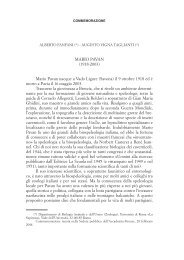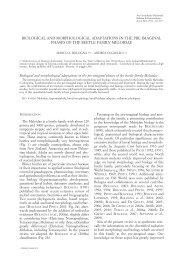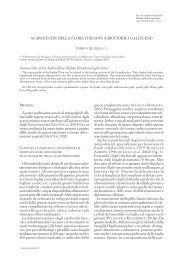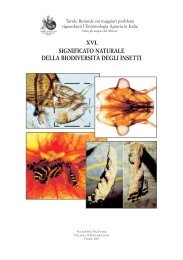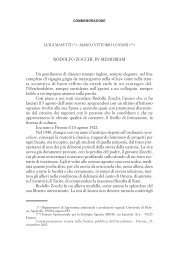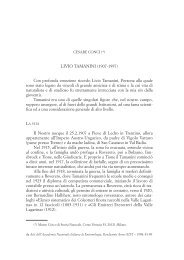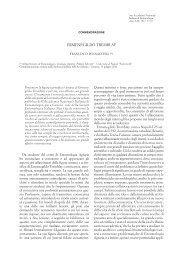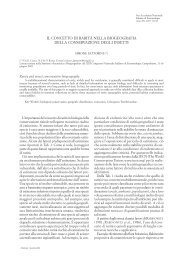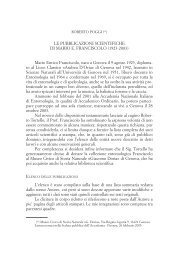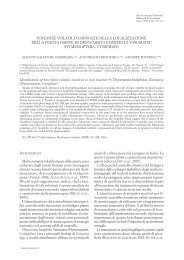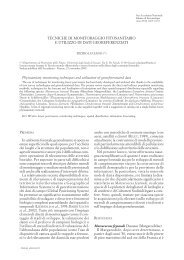XXII CNIE - Accademia nazionale italiana di Entomologia
XXII CNIE - Accademia nazionale italiana di Entomologia
XXII CNIE - Accademia nazionale italiana di Entomologia
Create successful ePaper yourself
Turn your PDF publications into a flip-book with our unique Google optimized e-Paper software.
is to a major degree controlled by atmospheric circulation patterns and often depends on<br />
extreme climatic events (Greenslade et al. 1999). Insects may profit, because of their<br />
small size, from ocean and air currents or migration of hosts/vectors to colonise new<br />
ecological areas. The recent arrival of the migratory moth Plutella xylostella, a<br />
cosmopolitan vegetable pest, into Svalbard Island (High Arctic - Norway) was due to an<br />
unusual air mass that crossed from West Russia (Coulson et al. 2002). Increased<br />
temperatures may also prolongate the flying period of insects and thereby enable them to<br />
become <strong>di</strong>spersed over greater <strong>di</strong>stances (Ott 2009). For instance, migration patterns of<br />
the silver Y moth, Autographa gamma (Lepidoptera: Noctuidae), to Britain are largely<br />
influenced by the changes in temperatures and rainfall in its overwintering sites of North<br />
Africa (Chapman et al., 2008). Using classical climate change scenarios, Harrington et<br />
al. (2007) also calculated that the first aphid occurrence is expected to occur, on average,<br />
one day earlier every four years in Europe.<br />
Global warming may facilitate colonization and successful reproduction<br />
The arrival of a non-native species does not automatically lead to successful<br />
establishment. Unless invaders reproduce clonally, are self compatible, apomictic or<br />
parthenogenic, occurring in sufficient numbers is one of the key prerequisites for<br />
establishing a founder population (Sax & Brown 2000; Lockwood et al 2005). If the<br />
population falls below a minimum population density, called the Allee threshold, it will<br />
likely go extinct naturally and the invasion will fail (Liebhold and Tobin, 2008). Many<br />
factors may generate Allee effects, such as a decrease in co-operation to find resources<br />
and avoid natural enemies, an increase of inbree<strong>di</strong>ng and an increase of reproduction<br />
<strong>di</strong>fficulties. In this regard, climatic factors might also have an important role if they can<br />
increase the per capita reproductive output for any given population density.<br />
Changes in climatic con<strong>di</strong>tions that result in a prolonged growing and reproductive<br />
period often provide con<strong>di</strong>tions that alien species may exploit (Hemerik et al. 2004).<br />
Species introduced from warmer regions to temperate areas have, until recently, been<br />
constrained by too short growing seasons, which prevented several species from<br />
becoming naturalized. This could be about to change. There is evidence of a strong<br />
association between patterns of the emergence of invasive gypsy moth, Lymantria<br />
<strong>di</strong>spar, and climatic suitability in Ontario/Canada (Régnière et al., 2009). The alien moth<br />
was trapped more frequently in this region since 1980. However, between 1992 and<br />
1997 a temporary decline in climatic suitability occurred and resulted in a pronounced<br />
reduction in the area of defoliation by this species. Since 1998, the trend reversed again<br />
with the consequence of resurgence in defoliation and increased frequency of moths in<br />
pheromone traps to the north and west in Ontario.<br />
In organisms for which population dynamics are mainly controlled by temperature,<br />
climate change may increase development rates and lead to the production of an<br />
ad<strong>di</strong>tional yearly generation (Jönsson et al. 2007, Kiritani 2006, Gomi et al. 2007). In<br />
Japan, recent climate change may have affected the life cycle, life-history traits and,<br />
hence, the spread of the American fall webworm, Hyphantria cunea. This invasive moth<br />
has recently expanded its range, mainly towards the North. In parallel, it shifted from a<br />
bivoltine to a trivoltine life-cycle in at least a part of its range, and important changes in<br />
some life-history traits, such as the critical photoperiod for <strong>di</strong>apause induction, have<br />
occurred (Gomi et al. 2007). In a similar way, the native spruce bark beetle Ips<br />
typographus is changing voltinism in European mountain forests as a consequence of the<br />
<strong>di</strong>sproportionately large warming at high elevations (Lange et al., 2006), with the<br />
possibility of producing unprecedented outbreaks, as it happened with the mountain pine<br />
beetle Dendroctonus ponderosae in British Columbia, Canada (Kurz et al., 2008), and<br />
this has potential implications for coniferous plantations elsewhere.<br />
13



